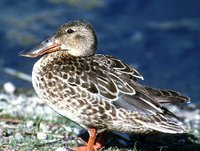Northern Shoveler
|
|
| Northern Shoveler Conservation status: Lower risk (lc) | ||||||||||||||
|---|---|---|---|---|---|---|---|---|---|---|---|---|---|---|
 A hen | ||||||||||||||
| Scientific classification | ||||||||||||||
| ||||||||||||||
| Binomial name | ||||||||||||||
| Anas clypeata Linnaeus, 1758 |
The Shoveler or Northern Shoveler (Anas clypeata) is a common and widespread duck which breeds in the northern areas of Europe and Asia and across most of North America.
This dabbling duck is strongly migratory and winters further south than its breeding range. It is not as gregarious as some dabbling ducks outside the breeding season and tends to form only small flocks.
This species is unmistakable in the northern hemisphere due to its large spatulate bill. The breeding male has a green head, white breast and chestnut belly and flanks. In flight, pale blue forewing feathers are revealed, separated from the green speculum by a white border.
The females are light brown, with plumage much like a female Mallard, but their long broad bill easily identifies them. The female's forewing is grey.
In non-breeding (eclipse) plumage, the drake looks more like the female.
It is a bird of open wetlands, such as wet grassland or marshes with some emergent vegetation, and feeds by dabbling for plant food, often by swinging its bill from side to side and using the bill to strain food from the water. This bird also eats mollusks and insects in the nesting season. The nest is a shallow depression on the ground, lined with plant material and down, usually close to water.
This is a fairly quiet species. The male has a clunking call, whereas the female has a mallard-like quack.bg:Клопач da:Skeand de:Löffelente fr:Canard souchet lt:Šaukštasnapė antis nl:Slobeend ja:ハシビロガモ pl:Płaskonos fi:Lapasorsa zh:琵嘴鸭 sv:Skedand
Categories: Ducks | Anas
